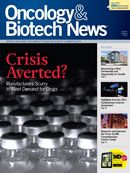Publication
Article
Oncology & Biotech News
The Final Word on CYP2D6 Testing and Tamoxifen?
Author(s):
CYP2D6 phenotype status does not predict tamoxifen efficacy in patients with early-stage breast cancer, according to a retrospective analysis of data from the Breast International Group
CYP2D6 phenotype status does not predict tamoxifen efficacy in patients with early-stage breast cancer, according to a retrospective analysis of data from the Breast International Group (BIG) 1-98 trial1 presented at SABCS. Freya R. Schnabel, MD, professor of surgery, NYU School of Medicine, discussed the findings at the JTCC’s SABCS review. Based on the negative results, Schnabel believes there is no current justification for CYP2D6 pharmacogenetic testing prior to administering tamoxifen.
CYP2D6 is involved in the formation of endoxifen, a metabolite linked to tamoxifen’s efficacy. Previous research, including Schroth et al2, had suggested an association between lower CYP2D6 activity and worse clinical outcomes with tamoxifen treatment. Schnabel admitted the data had been convincing. “I was very sold on the idea that CYP2D6 profiling would be important in the consideration of women who were going to take tamoxifen for chemoprevention,” she told conference attendees. However, subsequent research, including the BIG 1-98 retrospective analysis, altered Schnabel’s opinion.
The BIG 1-98 trial examined tamoxifen and letrozole1 administered alone and sequentially as adjuvant treatment in 8010 postmenopausal women with early-stage, endocrine-responsive breast cancer. At SABCS, Brian Leyland-Jones, MD, PhD, professor of medicine at Emory University, in Atlanta, presented data from a subanalysis of 2675 BIG 1-98 patients who had received monotherapy with either tamoxifen or letrozole.1 The patients were genotyped for CYP2D6 and categorized as poor, intermediate, or extensive metabolizers. The primary endpoint was breast cancer—free survival.
The researchers discovered no association between CYP2D6 status and breast cancer—free survival. Defying expectations, clinical outcomes were not worse in poor and intermediate metabolizers than in extensive metabolizers. Previous chemotherapy treatment was also not a factor. The results suggest CYP2D6 genotyping will provide no indication of tamoxifen’s potential effectiveness.
The study also investigated whether CYP2D6 phenotypes associated with reduced enzyme activity produced fewer hot flashes, a common side effect of tamoxifen. It has been theorized that lower enzyme activity would reduce tamoxifen’s activity, and thus lower the incidence of its side effects, including hot flashes. However, the BIG 1-98 subanalysis results showed no association between hot flash occurrence and metabolizer status. Hot flashes occurred in poor, intermediate, and extensive metabolizers at rates of 48%, 49%, and 42%, respectively. Based on these statistically insignificant differences, the study concluded that hot flash incidence should not be a marker of tamoxifen efficacy.
The negative results of Leyland- Jones et al’s study, along with the similar outcome of Rae et al’s3 retrospective analyses presented at SABCS, have established a convincing argument against CYP2D6 genotyping prior to tamoxifen administration. The CYP2D6 controversy will likely continue, however, until the completion of prospective analyses such as the Eastern Cooperative Oncology Group’s ongoing E3108 study (http://bit.ly/ i39SJc).
For her part, Schnabel has doubts that the prospective trials will shift the pendulum back toward testing. “Prospective trials are critical, but the data presented by Dr Rae and Dr Leyland- Jones were compelling. I will await the results of these trials with interest, but I am now a bit skeptical, and the proof will have to be very strong to influence practice in favor of testing.”
References
- Leyland-Jones B, Regan MM, Bouzk M, et al. Outcome according to CYP2D6 genotype among postmenopausal women with endocrineresponsive early invasive breast cancer randomized in the BIG 1-98 trial. Presented at: 33rd Annual San Antonio Breast Cancer Symposium; December 9-12, 2010; San Antonio, TX.
- Schroth W, Goetz MP, Hamann U, et al. Association between CYP2D6 polymorphisms and outcomes among women with early stage breast cancer treated with tamoxifen. JAMA. 2009;302(13):1429-1436.
- Rae JM, Drury S, Hayes DF, et al. Lack of correlation between gene variants in tamoxifen metabolizing enzymes with primary endpoints in the ATAC trial. Presented at: 33rd Annual San Antonio Breast Cancer Symposium; December 9-12, 2010; San Antonio, TX.










